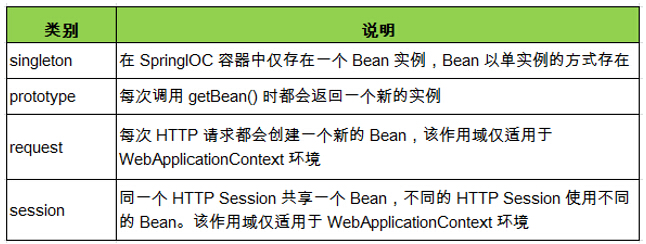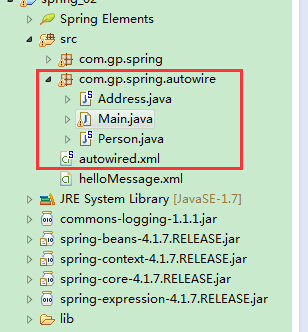Spring -- Bean自动装配&Bean之间关系&Bean的作用域
对于学习spring有帮助的网站:http://jinnianshilongnian.iteye.com/blog/1482071Bean的自动装配Spring IOC 容器可以自动装配 Bean. 需要做的仅仅是在的 autowire 属性里指定自动装配的模式有以下几种自动装配的类型:byType(根据类型自动装配): 若 IOC 容器中有多个与目标 Bean 类型一致的 Bean. 在
对于学习spring有帮助的网站:http://jinnianshilongnian.iteye.com/blog/1482071
Bean的自动装配
Spring IOC 容器可以自动装配 Bean. 需要做的仅仅是在 的 autowire 属性里指定自动装配的模式
有以下几种自动装配的类型:
- byType(根据类型自动装配): 若 IOC 容器中有多个与目标 Bean 类型一致的 Bean. 在这种情况下, Spring
将无法判定哪个 Bean 最合适该属性, 所以不能执行自动装配. - byName(根据名称自动装配): 必须将目标 Bean 的名称和属性名设置的完全相同.
- constructor(通过构造器自动装配): 当 Bean 中存在多个构造器时, 此种自动装配方式将会很复杂. 不推荐使用
首先我们先来看一个手动装配的例子,
目录结构
先创建两个实体Bean
package com.gp.spring.autowire;
public class Person {
private String name;
private Address address;
public String getName() {
return name;
}
public void setName(String name) {
this.name = name;
}
public Address getAddress() {
return address;
}
public void setAddress(Address address) {
this.address = address;
}
@Override
public String toString() {
return "Person [name=" + name + ", address=" + address + "]";
}
}
package com.gp.spring.autowire;
public class Address {
private String city;
private String street;
public String getCity() {
return city;
}
public void setCity(String city) {
this.city = city;
}
public String getStreet() {
return street;
}
public void setStreet(String street) {
this.street = street;
}
@Override
public String toString() {
return "Address [city=" + city + ", street=" + street + "]";
}
}
再创建IOC配置文件
<?xml version="1.0" encoding="UTF-8"?>
<beans xmlns="http://www.springframework.org/schema/beans"
xmlns:xsi="http://www.w3.org/2001/XMLSchema-instance" xmlns:util="http://www.springframework.org/schema/util"
xmlns:p="http://www.springframework.org/schema/p"
xsi:schemaLocation="http://www.springframework.org/schema/beans
http://www.springframework.org/schema/beans/spring-beans.xsd
http://www.springframework.org/schema/util
http://www.springframework.org/schema/util/spring-util-4.0.xsd">
<bean id="address" class="com.gp.spring.autowire.Address"
p:city="beijing" p:street="haidian"></bean>
<bean id="person" class="com.gp.spring.autowire.Person"
p:name="Alis" p:address-ref="address"></bean>
</beans>
测试代码
package com.gp.spring.autowire;
import org.springframework.context.ApplicationContext;
import org.springframework.context.support.ClassPathXmlApplicationContext;
public class Main {
public static void main(String[] args) {
ApplicationContext ctx = new ClassPathXmlApplicationContext(
"autowired.xml");
Person p = (Person) ctx.getBean("person");
System.out.println(p);
}
}
输出结果
Person [name=Alis, address=Address [city=beijing, street=haidian]]
下面我们来看一下是如何进行自动装配的
修改配置文件
<bean id="address" class="com.gp.spring.autowire.Address"
p:city="beijing" p:street="haidian"></bean>
<bean id="person" class="com.gp.spring.autowire.Person"
p:name="Alis" autowire="byName"></bean>增加代码autowire=”byName”,使用byName的方式进行自动匹配。
它就会根据person类中的setAddress属性匹配名为address的bean。
同理可知,byType匹配方式,匹配与setAddress类型一直的bean。
XML 配置里的 Bean 自动装配的缺点
- 在 Bean 配置文件里设置 autowire 属性进行自动装配将会装配 Bean 的所有属性. 然而, 若只希望装配个别属性时,
autowire 属性就不够灵活了. - autowire 属性要么根据类型自动装配, 要么根据名称自动装配, 不能两者兼而有之.
- 一般情况下,在实际的项目中很少使用自动装配功能,因为和自动装配功能所带来的好处比起来,明确清晰的配置文档更有说服力一些
Bean的继承关系
- Spring 允许继承 bean 的配置, 被继承的 bean 称为父 bean. 继承这个父 Bean 的 Bean 称为子 Bean
- 子 Bean 从父 Bean 中继承配置, 包括 Bean 的属性配置
- 子Bean也可以覆盖从父Bean中继承过来的属性
- 父 Bean 可以作为配置模板, 也可以作为 Bean 实例. 若只想把父 Bean 作为模板, 可以设置 bean的abstract 属性为 true, 这样 Spring 将不会实例化这个 Bean
来看下下面这段代码
<bean id="address1" class="com.gp.spring.autowire.Address"
p:city="鸡西" p:street="南岗"></bean>
<bean id="address2" class="com.gp.spring.autowire.Address"
p:city="鸡西" p:street="电台路"></bean> public static void main(String[] args) {
ApplicationContext ctx = new ClassPathXmlApplicationContext(
"context_relate.xml");
Address address = (Address) ctx.getBean("address1");
System.out.println(address);
address = (Address) ctx.getBean("address2");
System.out.println(address);
}输出结果
Address [city=鸡西, street=南岗]
Address [city=鸡西, street=电台路]
很简单的属性注入,你是否注意到再配置文件中,注入的两条信息,大部分内容是相同的,比如相同的Bean,相同的值。
这里我们可以用一个Bean继承的做法,来简化配置,如下
<bean id="address1" class="com.gp.spring.autowire.Address"
p:city="鸡西" p:street="南岗"></bean>
<bean id="address2" p:street="电台路" parent="address1"></bean>这里用到了parent,继承自address1的Bean,然后我们在重写我们要修改的内容。
抽象Bean(abstract=”true”)
抽象的Bean是不允许被实例化的,我们看一个错误的代码
<bean id="address1" class="com.gp.spring.autowire.Address"
p:city="鸡西" p:street="南岗" abstract="true"></bean>
<bean id="address2" p:street="电台路" parent="address1"></bean>address1增加了abstract=”true”表示为抽象Bean
public static void main(String[] args) {
ApplicationContext ctx = new ClassPathXmlApplicationContext(
"context_relate.xml");
Address address = (Address) ctx.getBean("address1");
System.out.println(address);
address = (Address) ctx.getBean("address2");
System.out.println(address);
}运行测试方法
我们会看到以下异常,意思为抽象类是不许被实现的。
Exception in thread “main” org.springframework.beans.factory.BeanIsAbstractException: Error creating bean with name ‘address1’: Bean definition is abstract
所以我们去掉address1的实现即可。
public static void main(String[] args) {
ApplicationContext ctx = new ClassPathXmlApplicationContext(
"context_relate.xml");
// Address address = (Address) ctx.getBean("address1");
// System.out.println(address);
Address address = (Address) ctx.getBean("address2");
System.out.println(address);
}通常抽象Bean用法,不指定具体的类,在其继承的子类中指定class,如下
<bean id="address1" p:city="鸡西" p:street="南岗" abstract="true"></bean>
<bean id="address2" class="com.gp.spring.autowire.Address"
p:street="电台路" parent="address1"></bean>
<bean id="address3" class="com.gp.spring.autowire.Address"
p:street="和平大街" parent="address1"></bean>依赖Bean的配置
当我们在注入Bean的信息的时候,如果要求某些信息必须录入,则这就是Bean的依赖。
比如我们注入一个person类信息,其中person有一个address的属性,前提要求address必须要被注入数据,这样这个人才有地址,也就是person依赖address
下面我们来看看代码
<bean id="address" class="com.gp.spring.autowire.Address"
p:street="和平大街" p:city="鸡西"></bean>
<bean id="person" class="com.gp.spring.autowire.Person"
p:name="pengpeng" depends-on="address"></bean>输出内容
Person [name=pengpeng, address=null]
如果我们去掉address
<!--
<bean id="address" class="com.gp.spring.autowire.Address"
p:street="和平大街" p:city="鸡西"></bean>
-->
<bean id="person" class="com.gp.spring.autowire.Person"
p:name="pengpeng" depends-on="address"></bean>会抛出一下异常
org.springframework.beans.factory.NoSuchBeanDefinitionException: No bean named ‘address’ is defined
如果前置依赖于多个 Bean,则可以通过逗号,空格或的方式配置 Bean 的名称
Bean的作用域
Bean的作用域可以理解为IOC容器中的Bean他的作用范围,我们通过以上的内容了解到获取到一个bean的信息通过以下方式
Address address1 = (Address) ctx.getBean("address");那比如现在我获取多个的时候会是什么样子的呢,我们做了下测试
public static void main(String[] args) {
ApplicationContext ctx = new ClassPathXmlApplicationContext(
"context_relate.xml");
Address address1 = (Address) ctx.getBean("address");
Address address2 = (Address) ctx.getBean("address");
System.out.println(address1 == address2);
}输出结果:true
可知IOC容器中的Bean都是单实例的。
我们可以通过scope来配置Bean的作用域,目前有四种 
其中主要用的singleton、prototype。默认情况是singleton。
下面修改IOC配置
<bean id="address" class="com.gp.spring.autowire.Address"
p:street="电台路" p:city="鸡西" scope="prototype"></bean>输出结果:false
另外两个request、session在web的应用开发中使用。后续用到的时候单独介绍。
使用外部属性文件
我们在开发的时候会使用spring注入JDBC的连接池信息,代码如下
<beans xmlns="http://www.springframework.org/schema/beans"
xmlns:xsi="http://www.w3.org/2001/XMLSchema-instance"
xmlns:context="http://www.springframework.org/schema/context"
xmlns:p="http://www.springframework.org/schema/p"
xsi:schemaLocation="http://www.springframework.org/schema/beans http://www.springframework.org/schema/beans/spring-beans.xsd
http://www.springframework.org/schema/context http://www.springframework.org/schema/context/spring-context-4.1.xsd">
<context:property-placeholder location="classpath:db.properties"/>
<bean id="db" class="com.gp.spring.jdbc.DataSource">
<property name="userName" value="${username}"></property>
<property name="password" value="${password}"></property>
</bean>
</beans>这里context:property-placeholder引入外部文件,然后通过${}方式获取信息。
db.properties代码如下
username=root
password=123456更多推荐
 已为社区贡献2条内容
已为社区贡献2条内容











所有评论(0)